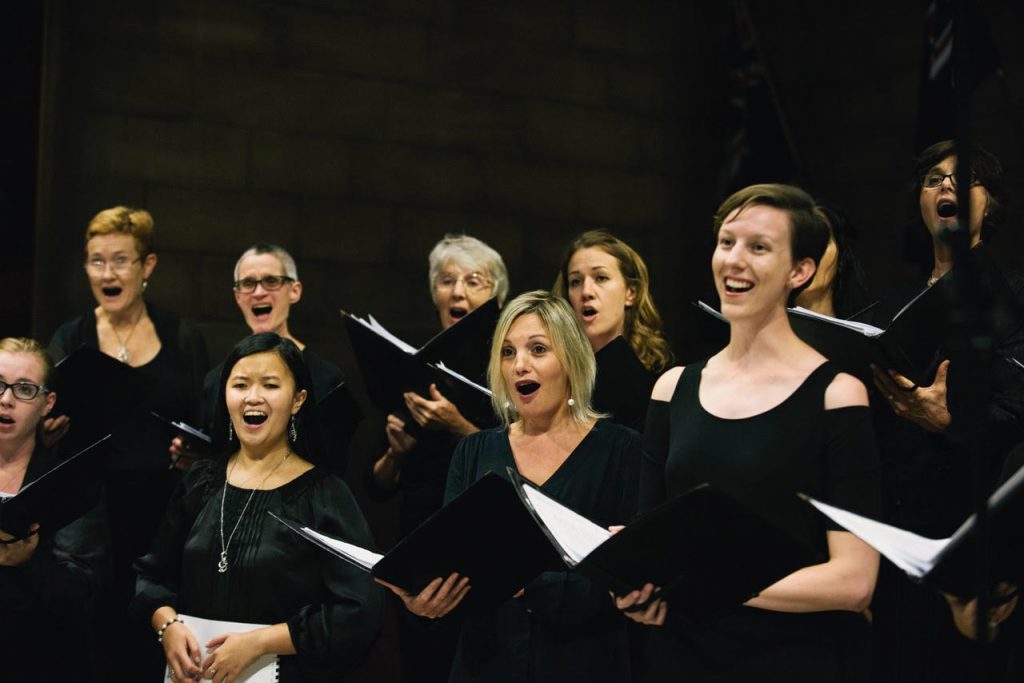Old coalesces with the new.
The program for this concert traversed temporal extremities – from music of the ars nova and ars subtilior which took hold of the Low Countries in the early Renaissance, to contemporary Australian choral music. It gave an opportunity for audiences to reflect on some essential similarities between these art forms, despite their apparent separation in time.

Minga Bagan, which the Sydney Chamber Choir has performed some years earlier, was a wonderful way to start. It foreshadowed the core themes of much of the contemporary music that was to follow – the need to restore choral music to its origins in ritual, dance and reflection.
Josquin’s Ave maria virgo serena was a profoundly serious composition. It displayed not only Josquin’s mastery of counterpoint – and was a good introduction to the sorts of rambling subjects and countersubjects so characteristic of the Franco-Flemish school – but also the Choir’s ability to maintain an independence of voices, especially between sopranos and altos. However, it seemed at times that the male voices were too diffident. Yet the coming-together of all voices for the declamation of ‘Ave vera virginitas’ in unison was a moment to behold.
Memory Pieces, by Stephen Adams, was a delightfully quirky piece. Reflecting the vagaries of the subconscious, the Choir pulled off the rapid changes in dynamics and tone quite well.
The articulation by all members of the Choir in de la Rue’s Absalon, fili mi was impressive. The piece has an added gravitas once it is realised that it depicts King David’s lament over the death of his son, Absalon. This was a piece that called for the strength not only of the superius but particularly of the bass and tenor voices, which were are at times quite faint.
One of the sheer highlights of the concert was Joe Twist’s Wonga Vine. It was a masterpiece in tone painting. The stark augmented chords for ‘eyes of fire’ and the repeated cascading of voices for ‘white waterfall’ were truly moments to behold. The coalescing of voices gave the impression throughout of twisting sinuous vines, and despite moments of great emotional intensity, the Choir left audiences calmed by the end. Much the same could be said of Gibson’s Let Them All Come which was a technical and emotional tour de force.
Another highlight was Ella Macens’ When the World Closes its Eyes which was a delightful composition, beginning forcefully with a declamation of the main theme by Naomi Crellin as solo alto. This piece, among others, was an opportunity for soprano Wei Jiang to showcase the remarkable clarity of her voice, and her impressive vocal dexterity.
The Choir made good use of the space in the Nielsen, selecting a few sopranos altos and tenors to perform Dufay’s Flos florum from the gallery above. This was the highpoint of the concert. It was a movingly intimate rendition of what is undoubtedly a difficult piece to sing. It features resolutions and intervals that are striking to modern ears (bearing in mind that period’s preoccupation with fifths and Pythagorean tuning), and interesting experimentations with metres.
These were features that also marked the piece that followed – Ross Edwards’ Flower Songs. It was a difficult piece to master (particularly because of the shifting metres), and features of Australia’s biodiversity shone through in interesting and unusual ways. But at times it was apt to excite the mind of the student more than the ears of a lay audience.
It is always a joy to experience a concert program that shows that, though time moves on, some musical styles and themes remain the same. But some of the contemporary music chosen for this program was at times challenging for audiences, though its execution was undoubtedly a great technical feat. As their recent performance of Haydn’s Creation showed, this Choir is at its best with spirited, vital and forceful music, and for that reason we all look forward to its November performance of Schutz and Tunder.
